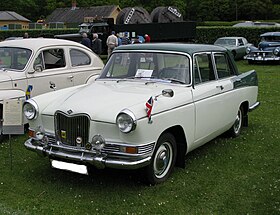Riley 4
| Riley 4 Farina-styled B-series |
|
|---|---|

Riley 4 / Seventy Two sports saloon
1622cc first registered 4 May 1966 |
|
| Overview | |
| Manufacturer | BMC |
| Production | 1959-1969 25,091 made |
| Body and chassis | |
| Class | full-size car |
| Related |
MG Magnette Mark III, Wolseley 15/60, Austin A55 Cambridge Mark II, Morris Oxford V Siam Di Tella 1500 Argentina |
| Chronology | |
| Predecessor | Riley RME 1945-1955 |
| Successor | none |
| Riley 4 / Sixty Eight | |
|---|---|

Riley 4 / Sixty Eight sports saloon
|
|
| Overview | |
| Also called | Riley Fordor (Spain) Siam Di Tella 1500 (Argentina) |
| Production | 1959-1961 10,940 made |
| Body and chassis | |
| Body style | 4-door saloon station wagon (Argentina) 2-door pick-up (Argentina) |
| Powertrain | |
| Engine | 1,489 cc (90.9 cu in) B-Series Straight-4 |
| Dimensions | |
| Wheelbase | 99.25 in (2,521 mm) track |
| Length | 178 in (4,521 mm) |
| Width | 63.5 in (1,613 mm) |
| Height | 57 in (1,448 mm) |
| Kerb weight | 36 cwt 2,604 lb (1,181 kg) |
| Riley 4 / Seventy Two | |
|---|---|

Riley 4 / Seventy Two sports saloon
1622cc first registered May 1963 |
|
| Overview | |
| Also called | Riley 1500 (Argentina) Riley Comet (Austria) |
| Production | 1961-1969 14,151 made |
| Body and chassis | |
| Body style | 4-door saloon |
| Powertrain | |
| Engine | 1,622 cc (99.0 cu in) B-Series Straight-4 |
| Dimensions | |
| Wheelbase | 100.5 in (2,553 mm) track |
| Height | 58 in (1,473 mm) |
The Riley 4 / Sixty Eight and Seventy Two are cars produced by BMC from 1959 to 1969, under the Riley marque. They are closely related to the Pinin Farina-designed MG Magnette Mark III and Wolseley 15/60 and the simpler Austin A55 Cambridge Mark II, Morris Oxford V pair, sharing the MG's rear styling and engine (with a milder cam). This Riley is the most expensive car in that series.
This model's introduction, using the same engine, did not affect production of the smaller-bodied 1½-litre Riley One-Point-Five sports saloon which continued until 1965.
Launched in April 1959, the 4 / Sixty Eight was the last of the five B series BMC Pininfarina cars to be released. The Riley used the twin-carburettor B-Series straight-4 engine in the form already familiar to drivers of the MG Magnette III, producing 64 bhp (48 kW). This was 6 hp (4.5 kW) more than the similar Wolseley 15/60.
From the outside the car was distinguished from its siblings by a Riley grille on the front and (apart from the MG with which it shared its tail treatment) slightly less acute tail fins at the back. Inside, the fascia was relatively well equipped: this was the only one of the five cars to come with a rev counter as standard equipment.
A car was tested by the British magazine The Motor in 1959 and had a top speed of 88.2 mph (141.9 km/h) and could accelerate from 0-60 mph (97 km/h) in 18.8 seconds. A fuel consumption of 27.3 miles per imperial gallon (10.3 L/100 km; 22.7 mpg‑US) was recorded. The test car cost £1028 including taxes.
It was intended to be the most luxurious of the Farina-styled B-series cars and was priced accordingly. A brief road test was published under the headline: "Comfort not Sacrificed to Appearance in New Riley". The motoring correspondent of The Times reported the more expensive Riley shared a similar specification with the MG Magnette Mark III but the Riley had different points of styling and its very full equipment included a tachometer. The driver sat upright and gained a sense of mastery of the car steering from the well-furnished interior which had the right combination of leather, walnut veneer and pile carpet. Gear changing was easy through a well-placed central lever.
...
Wikipedia
